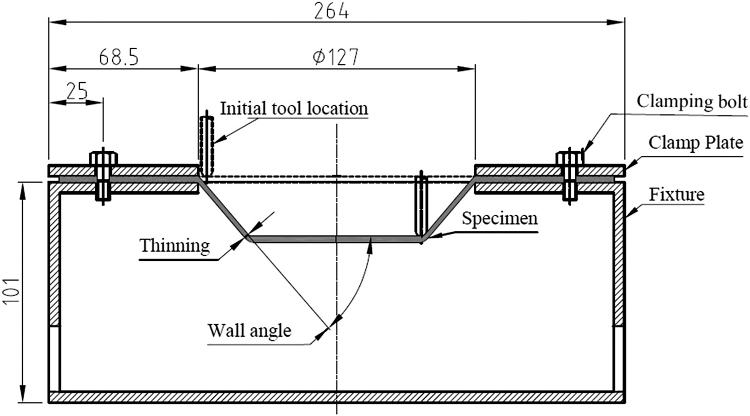Polymers exhibit certain optimal material properties such as being lightweight, specific strength, and rigidity. Hence they are increasingly used for various parts in the automotive industry to reduce the weight of the vehicle and thus the energy consumption. A batch forming process called single point incremental forming (SPIF) is considered in the Journal of Process Mechanical Engineering.
 Schematic diagram showing SPIF and fixture. Image Credit: Jain, P. S., et al., Journal of Process Mechanical Engineering, 1–9.
Schematic diagram showing SPIF and fixture. Image Credit: Jain, P. S., et al., Journal of Process Mechanical Engineering, 1–9.
Components from polymers are often mass-produced through molding, extrusion, thermoforming, etc., which involve using heat and pressure. These processes involve expensive equipment and tools and are not adaptable to change in product design. A batch forming process called single point incremental forming (SPIF) is economical, employs generalized tooling, and is adaptable to product design changes.
The process of SPIF is carried out using numerical control, and hence tool may be advanced through a specific path with the help of numerical programming. In general, this process is performed on CNC machines, where the tool can be effectively moved on a specific path using CNC programming.
Many studies have analyzed the formability of polymers under different conditions. However, studies on the effect of variation of parameters on responses within the forming limit are scarce. This study analyzes the effect of variation of feed rate, wall angle, and step size on parameters like spring back, surface roughness, and thinning while performing SPIF on polypropylene.
Experiment
For incremental forming, the specimens were prepared from polypropylene sheets by cutting the sheets with a side length of 265 mm. Holes of appropriate size were made to fix the sheet on the fixture using bolts. A computerized numerical control (CNC) machine was used to perform the experiment.
SPIF was performed on the CNC machine using a spherical tool at room temperature. After SPIF, the dimension of the specimen was changed when the sheet was unclamped from the fixture. This change is due to spring back. The spring back can be found by measuring the final dimension.
The surface roughness was measured at the inner surface of the deformed specimen using a roughness tester in a micro-meter. To measure the thickness after deformation, the quarter part of the deformed specimen was cut. The wall thickness was then measured by vernier at both ends. The average wall thickness was taken as the final thickness after deformation.
Results
The main effect presented is that the percentage of spring back increases with an increase in the step size and the tool diameter. However, there is a decrease in the percentage spring back with an increase in wall angle. The increase in the wall angle causes greater plastic deformation due to stretching than elastic deformation, and hence lower elastic recovery. This reduces the percentage spring back.
The surface roughness was found to increase with an increase in the wall angle, the tool diameter, and the step size. The increase in wall angle results in an increase in thinning. Thinning decreases with an increase in tool diameter, step size, and feed rate. However, the change in thinning with respect to the feed rate is very small.
When the polypropylene sheet is deformed through SPIF, for all three responses, tool diameter is found to be the crucial parameter. An increase in the tool diameter leads to an increase in the spring back and surface roughness but a decrease in thinning. Therefore, if the thickness of the sheet is selected suitably, the smaller tool diameter may be used for performing SPIF.
This shows that for manufacturing components with a smooth surface and the least spring back, minimum tool diameter and step size should be preferred. The forming time can be managed by selecting a higher feed rate.
Conclusion
The experiments on SPIF were performed using L27 Orthogonal array. The responses measured were: spring back, surface roughness, and thinning. Three parameters—tool diameter, wall angle, and step size—were found to be significant for surface roughness as well as thinning. The wall angle affected the surface roughness and thinning the most. An increase in the mean value of surface roughness was observed with the increase in wall angle.
A reduction in thinning was also observed with an increase in tool diameter. However, thinning increases with the increase in wall angle. Thinning was found to reduce with an increase in step size. Although feed rate is crucial, change in thinning with respect to the feed rate is negligible.
The most significant factor for surface roughness and thinning was found to be wall angle. By contrast, tool diameter was found to have a major impact on the spring back of the propylene sheet during SPIF.
A higher wall angle reduces spring back but increases thinning and roughness. A decrease in the step size reduces roughness and spring back but increases thinning. An increase in feed rate will lead to a decrease in thinning.
This shows that forming time and spring back can be decreased through a higher feed rate. To achieve a better surface finish with decreased thinning and spring back, the tool diameter, step size, and wall angle should be set to the minimum value.
Journal Reference:
Jain, P. S., et al. (2021) An analysis of the effect of various parameters on surface roughness, springback and thinning while performing single point incremental forming on polypropylene sheet. Proceedings of the Institution of Mechanical Engineers, Part E: Journal of Process Mechanical Engineering. https://journals.sagepub.com/doi/abs/10.1177/09544089211047203